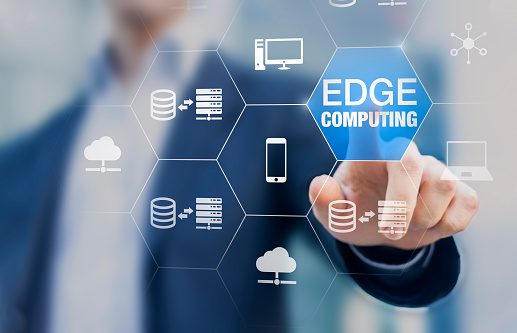Transformation of Edge | Cloud Computing Companies
Introduction#

Organizations are constantly concentrating on lowering network latency and computing delay duration, as well as the volume of data communicated or maintained in the server. Organizations recognise the need to modify their processing practices and are adopting Edge Computing to speed their Digitalization activities [(Dokuchaev, 2020)]. The job of digital transformation is primarily reliant on data processing. However, to make substantial modifications, organisations must frequently make major changes as far as how data is being collected, handled, and analysed. As organizational edge computing apps acquire traction, it is increasingly evident how much they will interact with digitalization programmes. Edge computing might be the connection that amplifies prospective corporate goals in the form of different continuous innovations, such as deep learning or the Internet of things.
Traditional cloud Vs. Edge Computing#
The traditional cloud-based model relies on a centralized database, where data is obtained on the periphery and then transported to the main data centres for analysis. Edge computing negates such a need to send raw information to the central network infrastructure. It implements a decentralized IT infrastructure in which data is processed near the edge, in which it is created and absorbed and it also empowers more instantaneous impact of analysis tools and AI functionality.
Edge Computing's Role in Digital Transformation
Edge Computing's role in Digital Business transformation could indeed allow rapid, less constrictive data processing, allowing for additional insight, quicker reaction times, and enhanced client interactions. Edge and AI-powered products and AI can instantly comprehend, understand, and make decisions and Data processes. Edge Computing on Internet of things devices can significantly decrease delay, boost performance, and enable enhanced decisions, laying the groundwork for simplified IT facilities. Furthermore, the coming of 5G technology, paired with both the potential of Edge Computing and IoT, has the potential to provide endless future opportunities.
Edge Computing's Digital Transformation across various business#
Manufacturing & Operations
Edge computing enables improved preventative analysis, improves efficiency, and energy usage, and improves dependability and effective availability in industrial enterprises [(Albukhitan, 2020)]. Edge Computing may assist businesses in making quicker and more effective marketing choices about their operational functions. Edge computing may be extremely advantageous for manufacturers engaged in places with limited or non-existent broadband.
Distribution Network

A lot of things happen along the distribution chain's edge, and a much may go incorrect. Businesses may extend the accessibility and exposure of their distribution networks by separating activities into groups of lesser, relatively controllable activities by digitally linking and managing the operations at the edge. The information gained from the edges of distribution networks, supported by AI and computerized technologies, would assist businesses to efficiently respond to market circumstances, foresee lengthy patterns ahead of their rivals, and adapt plans at the moment down to its regional scale [(Ganapathy, 2021)].
Workplace security#
Edge computing has the potential to improve safety regulations across enterprises. The said Edge technology could indeed integrate and interpret information from on-site camera systems, worker security devices, and numerous other detectors to assist businesses in keeping tabs on employment conditions or make sure that all staff have significant compliance safety procedures, particularly when a place of work is distant or exceptionally risky [(Atieh, 2021)].
Autonomous Vehicles#
To function properly, autonomous cars will have to collect and evaluate massive volumes of data about their settings, routes, weather patterns, communicating with several other on-road automobiles, and so forth [(Liu et al., 2019)]. Edge Computing will allow self-driving cars to gather, analyse, and distribute information in real-time across automobiles and larger networks.
Retail#
Edge Computing may assist retail enterprises in maximising the usage of IoT devices and transmitting a multitude of data in real-time including monitoring, inventory management, retail sales, and so on [(Ganapathy, 2021)]. This innovation may be used to fuel Artificial intelligence and machine learning technologies, and also uncover commercial possibilities such as an efficient endcap or promotion, anticipate sales, optimise supplier procurement, and so forth.
Healthcare#
The healthcare business has seen an exponential increase in the amount of client data collected by gadgets, monitors, as well as other medical devices. Edge Computing enables organisations to gain access to data, particularly issue data, so that professionals may take quick action to assist patients to prevent health crises instantaneously (Hartmann, Hashmi and Imran, 2019).
Conclusion#
Since Edge Computing has yet to see widespread acceptance, the potential of this digitalization cannot be underestimated. Edge Computing, being the most practical infrastructure for placing computing infrastructure directly to the data source, may help organisations accelerate their Digital Transformation emphasis. The edge technology's importance will be seen broadly soon because it can successfully handle developing network difficulties connected with transporting massive amounts of data that enterprises create and consume today. It is no longer only an issue of quantity, but also of latencies because apps rely on analysis and reactions that are more time-sensitive.